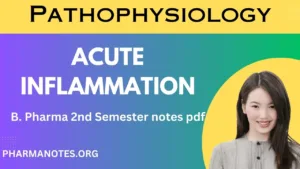Acute inflammation

Objective
At the end of this PDF, student will be able to
• Explain the main processes of cellular phase of inflammatory response
• Describe the events taking place in the cellular phase
• Explain the fate of acute inflammation
Acute inflammation
Cellular events in acute inflammation
Cellular phases of inflammation comprises of two processes
• Exudation of leucocytes
• Phagocytosis
Exudation of leucocytes
1. Changes in the formed elements of blood
• Early stage of inflammation
• Increased rate of blood flow – vasodilatation – slowing or stasis of bloodstream
• Central stream of cells widens and peripheral plasma zone becomes narrower – exudation
• Margination – redistribution – neutrophils of the central column come close to the vessel wall – pavementing
2. Rolling and adhesion:
Selectins – Helps rolling of neutrophills over endothelial cells
– P-selectin – rolling
– E-selectin – associated with both rolling and adhesion
– L-selectin – responsible for homing of circulating lymphocytes to the endothelial cells in lymph nodes
Integrins
• Activated during the process of loose and transient adhesions
• Between endothelial cells and leucocytes
• Stimulation receptors for integrins on the neutrophils
• Firm adhesion between leucocyte and endothelium
Immunoglobulin gene superfamily adhesion molecule intercellular adhesion molecule-1 (ICAM-1),
• Vascular cell adhesion molecule-1 (VCAM-1) – tighter adhesion and stabilise the interaction between leucocytes and endothelial cells
• Platelet-endothelial cell adhesion molecule- 1 (PECAM-1) or CD31 – leucocyte migration from the endothelial surface
3. Emigration and diapedesis :
• Sticking of neutrophils to the endothelium
• Movement along the endothelial surface
• Cytoplasmic pseudopods – cross the basement membrane – damage – collagenases – extravascular space – emigration
• Neutrophils are dominant first 24 hours
• Monocyte-macrophages – 24-48 hours
Diapedesis – passive phenomenon
• RBCs being forced out
• Raised hydrostatic pressure
• Escape through the endothelial defects
• Diapedesis gives haemorrhagic appearance to the inflammatory exudate
4. Chemotaxis:
Chemotactic factor-mediate transmigration of leucocytes
• Leukotriene B4 (LT-B4)
• Components of complement system (C5a and C3a)
• Cytokines (Interleukins, in particular IL-8)
• Soluble bacterial products (such as formylated peptides)
• Chemokines e.g. monocyte chemoattractant protein (MCP-1), eotaxin – eosinophils, NK cells- virally infected cells
Phagocytosis
Engulfment of solid particulate material by the cells – phagocytes
• Polymorphonuclear neutrophils (PMNs) – acute inflammatory response – microphages
• Circulating monocytes and fixed tissue mononuclear phagocytes – macrophages
Process involves 4 stages
• Recognition and attachment
• Engulfment
• Degranulation
• Killing and degradation
1. Recognition and attachment
• Phagocytes & microorganism – have similar charges
• Phagocytes covered with opsonin to facilitate bond
• IgG opsonin
• C3b fraction of complement system
2. Engulfment
• After opsonisation, particle ready to be engukfed
• Cytoplasmic pseuodopods extend out from phagocytes
• Phagocytic vacuole
• Plasma membrabe enclosing phagocytic vacuole breaks
• Engulfed material lies free in cytoplasm
• Lysosome + Phagocytic vacuole = Phagolysosome
3. Secretion (Degranulation)
• Enzyme stored with in preformed granule are secreted into phagosome & extracellular environment
• Primary or azurophillic granules – fuse with lysosome
• Secondary or specific granules are discharged
4. Killing and degradation
Microorganisms – killed by antibacterial substances – degraded by hydrolytic enzymes
• Oxygen dependent bactericidal mechanism
• Oxygen independent bactericidal mechanism
• Nitric oxide
MPO-dependent killing:
• Enzyme MPO acts on hydrogen peroxide in the presence of halides to form corresponding hypohalous acid – potent antibacterial
MPO independent bactericidal mechanism
• Mature macrophages lack the enzyme MPO
• OH— – Bactericidal activity
Oxygen independent killing bactericidal mechanism:
• Liberated lysosomal granules –
• lysis within phagosomes –
• lysosomal hydrolases,
• permeability increasing factors,
• cationic proteins (defensins),
• lipases, ptoteases, DNAases
Nitric oxide:
• Endothelial cells and activated macrophages
• Nitric oxide reactive free radicals – nitric oxide synthase – potent mechanism of microbial killing
Fate of acute inflammation
Summary
• Cellular phases of inflammation comprises of two processes -exudation of leucocytes and phagocytosis
• Exudation of leucocytes involves- changes in formed elements, rolling & adhesion, emmigration& diaphesis and invasion
• Phagocytosis involves cell eating
• Fate of acute inflammation may be healing, regeneration, suppuration or may develop into chronic inflammation







